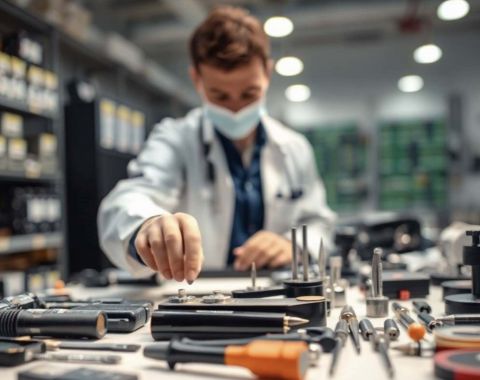Must-Have Tech Stack for Cutting-Edge Medical Design

"Why settle for ‘good enough’ tools when medical innovation demands the best?
- Alex, Associate Partner at DDI
In the fast-paced world of medical device design, having the right technology at your fingertips is crucial. It's not just about the software and hardware; it's about how these tools streamline your workflow, enhance collaboration, and ultimately help you deliver innovative, patient-centric solutions. Here’s my current tech stack that keeps me on the leading edge of medical design—without overcomplicating the process:
1. Robust Parametric CAD Software for Efficient Medical Device Prototyping:
When it comes to medical device development, I rely heavily on robust parametric CAD software. This approach allows for quick iteration of shape and structure, which is essential in the dynamic landscape of medtech. While surface modeling packages have their place, parametric modeling is generally preferable for detailed component design in medical devices, enabling precise control and easy modification. This design software and these CAD software tools are fundamental to our 3D modeling process.
2. Cloud Collaboration for Seamless Medical Device Development Teams:
Real-time feedback from colleagues and clients, no matter their location, is a game-changer in medical device innovation. Cloud collaboration platforms, whether it's Google Suite or Microsoft 365, facilitate remote collaboration and seamless communication within medical device development teams. While seemingly common, the widespread and effective adaptation of these tools within medtech teams is still evolving. This real-time interaction is vital for efficient medical device design reviews and faster iteration cycles, improving overall project management.
3. Integrated Simulation Tools for Early Medical Device Analysis:
Baking stress, fluid flow, or motion analysis right into early medical device prototypes is incredibly powerful. The concept of creating a digital twin offers tremendous potential in medical device analysis. While simulation tools like those used for FEA and computational fluid dynamics cannot entirely replace functional testing of a medical device, the combination of the two provides invaluable insight into design performance. This leads to shorter medical device development cycles with a higher level of optimization and a better understanding of potential issues early on through virtual prototyping.
4. High-Resolution Rapid Prototyping Gear for Instant Medical Device Concept Validation:
For rapid medical device prototyping, high-resolution 3D printing is indispensable. The ability to instantly print prototypes and hold physical parts in your hand offers a low-cost and quick way to evaluate the form, fit, and initial functionality of your medical design. This immediate feedback loop is crucial for early-stage concept validation and informed design decisions in medtech through efficient additive manufacturing and streamlined design iteration.
5. Data Management for Organized Medical Device Design Files:
In medical device development, meticulous data management is paramount. Implementing robust version control and metadata tagging ensures that no piece of critical design data goes missing. Documenting major milestones with clear and readable presentations allows anyone to quickly understand the key elements of the medical device design in the future. This organized approach minimizes errors and streamlines the overall medical device design process, often supported by PDM or PLM systems.
Leveraging the right tech stack isn't just about having the latest gadgets. In medical device innovation, the right tools accelerate your design cycle, reduce errors, and ultimately help you deliver patient-centric solutions faster and more effectively.
Ready to leverage cutting-edge tools and expertise for your next medical device project? The team at Design Department is passionate about driving innovation in medtech. Let's discuss how our integrated approach and deep understanding of the latest technologies can help you bring your vision to life.
